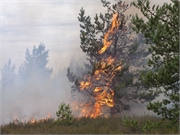- Understanding the Connection Between Anxiety and Depression
- How Daily Prunes Can Influence Cholesterol and Inflammation
- When to Take B12 for Better Absorption and Energy
- Epsom Salts: Health Benefits and Uses
- See What Saffron Can Do for Sleep and Heart Health
- 6 Common Mistakes to Avoid Before Your Physical
- Can Sweating Really Help You Beat a Cold?
- Strengthening Your Relationship: Practical Strategies
- Skip Storing This Everyday Product in the Fridge Door
- Green Tea + B3 Pairing May Boost Brain Health
Ozone, Wood Smoke Raise Odds of COPD in Smokers and Nonsmokers

High levels of ozone and wood smoke each increase the risk for lung diseases like chronic obstructive pulmonary disease (COPD) among smokers and nonsmokers alike, two new studies find.
People with COPD gradually lose their ability to draw a decent breath. Cigarette smoking is the leading cause, but COPD also can be caused by regular exposure to lung irritants.
In one study of nearly 1,900 participants, researchers found that exposure to high levels of ozone over a decade increased the likelihood of COPD.
For every 5-parts-per-billion increase in 10-year ozone exposure, the risk for COPD increased 16%, the findings showed.
The same increase in ozone was also linked with greater odds of emphysema and a worse quality of life, the study authors said.
“What really stood out was that the effect was apparent even among current heavy smokers,” said researcher Dr. Nadia Hansel, director of the pulmonary and critical care division at Johns Hopkins University School of Medicine, in Baltimore. “This means that active smoking doesn’t outweigh this effect of ozone.”
Even those already at risk for COPD had an additional increased risk with ozone exposure, she added in a university news release.
“I think this adds to increasing evidence that there is probably no healthy level of ozone,” Hansel said.
Her team’s findings were published online recently in JAMA Internal Medicine.
In the second study, published recently in the American Journal of Respiratory and Critical Care Medicine, a research team that included Hansel found that the use of wood as a main heating source was tied to an increased prevalence of lung disease among people who had never smoked.
Among 8,500 adults in the U.S. National Health and Nutrition Examination Surveys for 2007 to 2012, the investigators found that the prevalence of COPD among those living in rural areas was 12%, which was double the prevalence of the disease in urban areas.
Delving into the difference, the scientists found that places where a lot of coal or wood was used for primary heating showed greater odds of people having COPD.
A 1% increase in the number of homes using wood for heat was tied with a 12% increase in the odds of COPD among people who had never smoked, the researchers reported.
According to researcher Dr. Sarath Raju, a pulmonary and critical care medicine fellow at Hopkins, “Wood smoke is a household source of pollution that is associated with high levels of particulate matter and toxic gases. We hope that this paper raises awareness of the growing epidemic of rural COPD.”
More information
For more on COPD, head to the U.S. National Heart, Lung, and Blood Institute.
Source: HealthDay
Copyright © 2026 HealthDay. All rights reserved.










